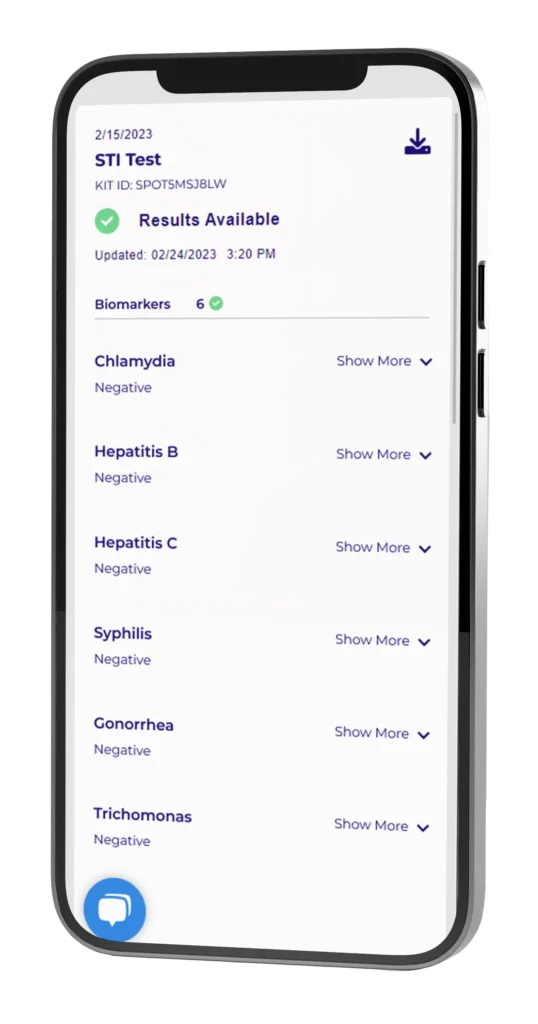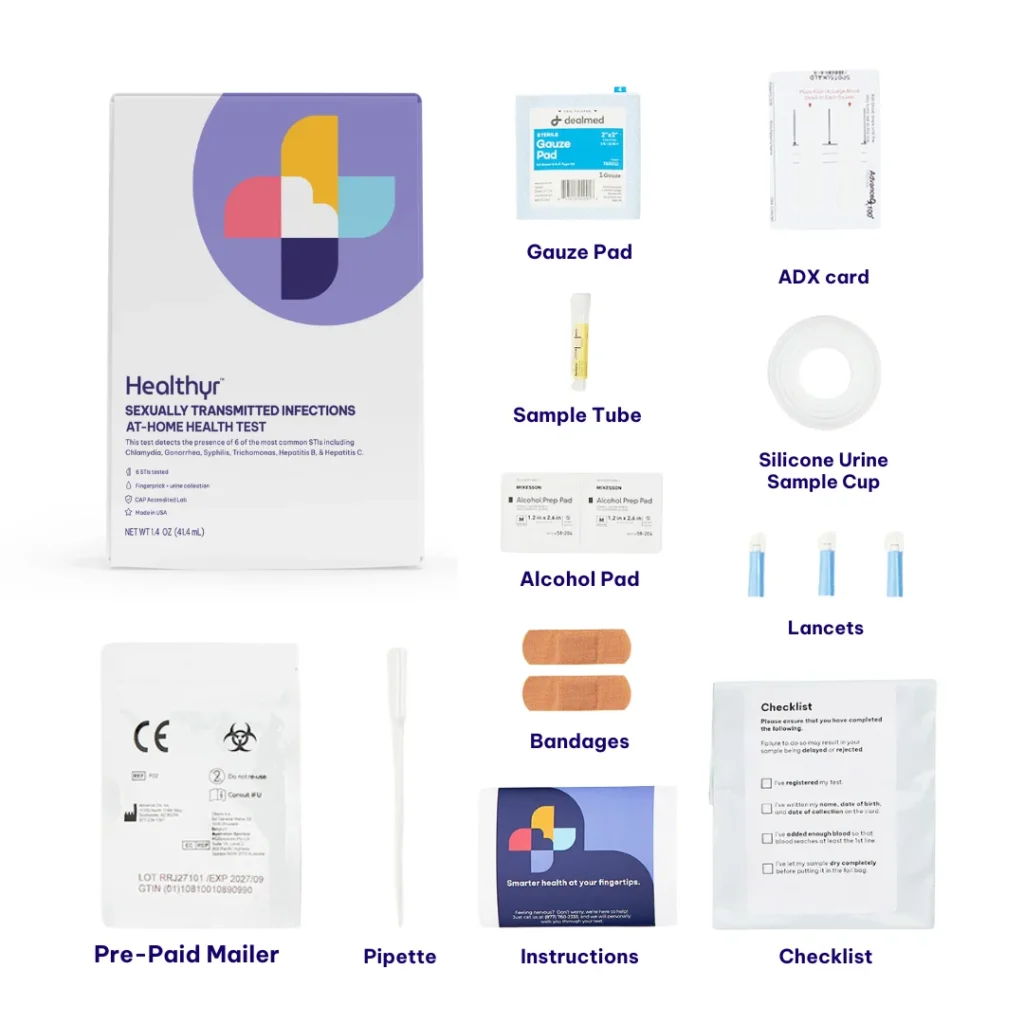STI + HIV Test
$129.99
Free Shipping
Skip the trip to the clinic and test yourself today for the 7 most common Sexually Transmitted Infections. Take control of your sexual health with our at-home STI test.
Not available in NY State.
Tests For:
Chlamydia, Gonorrhea, Syphilis, Trichomoniasis, HIV, Hepatitis B, Hepatitis C.

Pay in 4 easy payments with PayPal Pay Later or Afterpay
STI Test
$127.99
Free Shipping
Skip the trip to the clinic and test yourself today for the 6 most common Sexually Transmitted Infections. Take control of your sexual health with our at-home STI test.
Not available in NY State.
Tests For:
Chlamydia, Gonorrhea, Syphilis, Trichomoniasis, Hepatitis B, Hepatitis C.



Pay in 4 easy payments with PayPal Pay Later or Afterpay
- FSA/HSA Eligible
- For adults 18+
- Results in 7 days
- FSA/HSA Eligible
- For adults 18+
- Results in 7 days
Infections tested
- Chlamydia
- Gonorrhea
- Hepatitis B
- Hepatitis C
- Human Immunodeficiency Virus 1
- Human Immunodeficiency Virus 2
- Syphilis
- Trichomonas
Chlamydia
Chlamydia is caused by a bacteria that most commonly infects the cervix in women and the urethra in men. While infections can also occur in the rectum, throat, and eyes, the Healthyr STI panel only detects infections in the vagina and penis.
Chlamydia
What is it and how does it affect me?
Chlamydia is caused by a bacteria that most commonly infects the cervix in women and the urethra in men. While infections can also occur in the rectum, throat, and eyes, the Healthyr STD panel only detects infections in the vagina and penis. The bacteria is most commonly spread through vaginal, anal, and oral sex. While most people with chlamydia do not experience symptoms, in women the infection may cause discharge from the cervix, cervical bleeding, painful urination or sex, tenderness in the cervix, or increased frequency of urination. In men chlamydia can cause discharge from the penis, painful urination, or tenderness, pain, or swelling of the testicles. The Healthyr chlamydia test looks for genetic material from the bacteria in your urine, indicating an active infection.
Gonorrhea
Gonorrhea is caused by a bacteria that most commonly infects the urethra of the penis and vagina, as well as the cervix in women. While infections can also occur in the rectum, throat, and eyes, the Healthyr STI panel only detects infections in the vagina and penis.
Gonorrhea
What is it and how does it affect me?
Gonorrhea is caused by a bacteria that most commonly infects the urethra of the penis and vagina, as well as the cervix in women. While infections can also occur in the rectum, throat, and eyes, the Healthyr STD panel only detects infections in the vagina and penis. The bacteria is most commonly spread through vaginal, anal, and oral sex.
While most people with gonorrhea do not experience symptoms, in women the infection may cause discharge from the cervix, vaginal bleeding, painful urination or sex, or increased frequency of urination. In men gonorrhea can cause discharge from the penis, painful urination, or tenderness, pain, or swelling of the testicles. The Healthyr gonorrhea test looks for genetic material from the bacteria in your urine, indicating an active infection.
Hepatitis B
Hepatitis B (Hep B) is a virus that infects the liver and is mostly commonly spread through vaginal sex, anal sex, or sharing injectable drug equipment like needles and syringes.
Hepatitis B
What is it and how does it affect me?
Hepatitis B (Hep B) is a virus that infects the liver and is mostly commonly spread through vaginal sex, anal sex, or sharing injectable drug equipment like needles and syringes. Symptoms of acute infection usually appear within 3 months of exposure, but it’s possible to be infected with Hep B without experiencing any symptoms.
The Healthyr Hep B test looks for viral genetic material in your blood, indicating an active infection. According to the Mayo Clinic, this type of test is able to detect Hep B 30 days after exposure to the virus.
Hepatitis C
Hepatitis C (Hep C) is a virus that infects the liver and is mostly commonly spread through sharing injectable drug equipment like needles and syringes but can also be spread through sexual activity.
Hepatitis C
What is it and how does it affect me?
Hepatitis C (Hep C) is a virus that infects the liver and is mostly commonly spread through sharing injectable drug equipment like needles and syringes but can also be spread through sexual activity.
Most people do not experience symptoms until decades after the initial infection. The Healthyr Hep C test looks for viral genetic material in your blood, indicating an active infection. According to the CDC, this type of test is able to detect Hep C 1 to 2 weeks after exposure to the virus.
Human Immunodeficiency Virus 1
*if applicable
Human Immunodeficiency Virus 1 (HIV-1) is the virus that causes Acquired Immunodeficiency Syndrome (AIDS) and is mostly commonly spread through vaginal sex, anal sex, or sharing injectable drug equipment like needles and syringes.
Human Immunodeficiency Virus 1
What is it and how does it affect me?
Human Immunodeficiency Virus 1 (HIV-1) is the virus that causes Acquired Immunodeficiency Syndrome (AIDS) and is mostly commonly spread through vaginal sex, anal sex, or sharing injectable drug equipment like needles and syringes.
The Healthyr HIV test looks for viral genetic material in your blood, indicating an active infection. According to the CDC, this type of test is able to detect HIV 10 to 33 days after exposure to the virus.
Human Immunodeficiency Virus 2
*if applicable
Human Immunodeficiency Virus 2 (HIV-2) is the virus that causes Acquired Immunodeficiency Syndrome (AIDS) and is mostly commonly spread through vaginal sex, anal sex, or sharing injectable drug equipment like needles and syringes. The Healthyr HIV test looks for viral genetic material in your blood, indicating an active infection. According to the CDC, this type of test is able to detect HIV 10 to 33 days after exposure to the virus.
Syphilis
Syphilis is caused by a bacteria that primarily spreads through contact with a syphilis sore (called a chancre) during vaginal, anal, or oral sex. This infection can be present for many years and several different symptoms can be attributed to the infection at different stages of the infection.
Syphilis
What is it and how does it affect me?
Syphilis is caused by a bacteria that primarily spreads through contact with a syphilis sore (called a chancre) during vaginal, anal, or oral sex. This infection can be present for many years and several different symptoms can be attributed to the infection at different stages of the infection.
The Healthyr STD test detects antibodies that your body produces to fight the bacteria that causes syphilis. In primary syphilis, a single firm, round, painless chancre appears at the location where the bacteria entered the body, usually on the penis, vagina, anus, or mouth. Because the chancre is painless, it often goes unnoticed, especially when it appears in hard to see places.
While it is common for a single chancre to appear, it is also possible for several chancres to appear. Chancres heal in about 3-6 weeks, but without treatment primary syphilis may develop to secondary syphilis. Secondary syphilis occurs as the initial chancre is healing or several weeks after it has healed.
Common symptoms of secondary syphilis include rashes or lesions on the vagina, anus, or mouth, but rashes can also occur anywhere on the body such as the palms of the hand or feet. The rash may also be accompanied by fever, sore throat, swollen lymph nodes, headaches, patchy hair loss, muscle weakness, and fatigue. The symptoms of secondary syphilis are often mistaken for other conditions, which has led syphilis to earn the nickname “”the great imitator.”” If syphilis is not treated through the secondary stage, then the infection enters the latent stage, which may last for decades.
While there are no symptoms associated with latent syphilis, leaving the infection untreated can eventually lead to damage to the heart, brain, nervous system, liver, eyes, and bones. The tertiary stage of syphilis occurs in about 15% to 30% of people who are not treated for their syphilis infection.
People with tertiary syphilis experience severe or life threatening complications with their heart, brain, nervous system, liver, eyes, and bones. Because the infection can affect so many different parts of your body, symptoms are wide ranging and can include severe headache, mental disorders, dementia, coronary artery disease, muscle weakness or paralysis, numbness, eye pain, eye redness, blurry vision, blindness, hearing loss, buzzing or ringing in the ears, difficulty with balance, dizziness or vertigo.
Trichomonas
Trichomonas vaginalis is a parasite that infects the lower genital tract in both men and women, but typically causes more symptoms women. While most people with trichomonas do not experience symptoms, the infection may cause discharge from the penis or vagina, genital redness or irritation, painful urination or sex, or a burning sensation in the penis or vagina.
Trichomonas
What is it and how does it affect me?
Trichomonas vaginalis is a parasite that infects the lower genital tract in both men and women, but typically causes more symptoms women. While most people with trichomonas do not experience symptoms, the infection may cause discharge from the penis or vagina, genital redness or irritation, painful urination or sex, or a burning sensation in the penis or vagina.
The Healthyr trichomonas test looks for genetic material from the parasite in your urine, indicating an active infection. This type of test is able to detect trichomonas 28 days after exposure.
Infections tested
Chlamydia
Gonorrhea
HIV
Syphilis
Trichomoniasis
Hepatitis B
Hepatitis C.
If applicable:
HIV 1 & 2
Chlamydia is caused by a bacteria that most commonly infects the cervix in women and the urethra in men. While infections can also occur in the rectum, throat, and eyes, the Healthyr STI panel only detects infections in the vagina and penis. The bacteria is most commonly spread through vaginal, anal, and oral sex. While most people with chlamydia do not experience symptoms, in women the infection may cause discharge from the cervix, cervical bleeding, painful urination or sex, tenderness in the cervix, or increased frequency of urination. In men chlamydia can cause discharge from the penis, painful urination, or tenderness, pain, or swelling of the testicles. The Healthyr chlamydia test looks for genetic material from the bacteria in your urine, indicating an active infection.
What is it and how does it affect me?
Gonorrhea is caused by a bacteria that most commonly infects the urethra of the penis and vagina, as well as the cervix in women. While infections can also occur in the rectum, throat, and eyes, the Healthyr STI panel only detects infections in the vagina and penis. The bacteria is most commonly spread through vaginal, anal, and oral sex. While most people with gonorrhea do not experience symptoms, in women the infection may cause discharge from the cervix, vaginal bleeding, painful urination or sex, or increased frequency of urination. In men gonorrhea can cause discharge from the penis, painful urination, or tenderness, pain, or swelling of the testicles. The Healthyr gonorrhea test looks for genetic material from the bacteria in your urine, indicating an active infection.
What is it and how does it affect me?
Hepatitis B (Hep B) is a virus that infects the liver and is mostly commonly spread through vaginal sex, anal sex, or sharing injectable drug equipment like needles and syringes. Symptoms of acute infection usually appear within 3 months of exposure, but it’s possible to be infected with Hep B without experiencing any symptoms. The Healthyr Hep B test looks for viral genetic material in your blood, indicating an active infection. According to the Mayo Clinic, this type of test is able to detect Hep B 30 days after exposure to the virus.
What is it and how does it affect me?
Hepatitis C (Hep C) is a virus that infects the liver and is mostly commonly spread through sharing injectable drug equipment like needles and syringes but can also be spread through sexual activity. Most people do not experience symptoms until decades after the initial infection. The Healthyr Hep C test looks for viral genetic material in your blood, indicating an active infection. According to the CDC, this type of test is able to detect Hep C 1 to 2 weeks after exposure to the virus.
What is it and how does it affect me?
Human Immunodeficiency Virus 1 (HIV-1) is the virus that causes Acquired Immunodeficiency Syndrome (AIDS) and is mostly commonly spread through vaginal sex, anal sex, or sharing injectable drug equipment like needles and syringes. The Healthyr HIV test looks for viral genetic material in your blood, indicating an active infection. According to the CDC, this type of test is able to detect HIV 10 to 33 days after exposure to the virus.
What is it and how does it affect me?
Human Immunodeficiency Virus 2 (HIV-2) is the virus that causes Acquired Immunodeficiency Syndrome (AIDS) and is mostly commonly spread through vaginal sex, anal sex, or sharing injectable drug equipment like needles and syringes. The Healthyr HIV test looks for viral genetic material in your blood, indicating an active infection. According to the CDC, this type of test is able to detect HIV 10 to 33 days after exposure to the virus.
What is it and how does it affect me?
Syphilis is caused by a bacteria that primarily spreads through contact with a syphilis sore (called a chancre) during vaginal, anal, or oral sex. This infection can be present for many years and several different symptoms can be attributed to the infection at different stages of the infection. The Healthyr STD test detects antibodies that your body produces to fight the bacteria that causes syphilis. In primary syphilis, a single firm, round, painless chancre appears at the location where the bacteria entered the body, usually on the penis, vagina, anus, or mouth. Because the chancre is painless, it often goes unnoticed, especially when it appears in hard to see places. While it is common for a single chancre to appear, it is also possible for several chancres to appear. Chancres heal in about 3-6 weeks, but without treatment primary syphilis may develop to secondary syphilis. Secondary syphilis occurs as the initial chancre is healing or several weeks after it has healed. Common symptoms of secondary syphilis include rashes or lesions on the vagina, anus, or mouth, but rashes can also occur anywhere on the body such as the palms of the hand or feet. The rash may also be accompanied by fever, sore throat, swollen lymph nodes, headaches, patchy hair loss, muscle weakness, and fatigue. The symptoms of secondary syphilis are often mistaken for other conditions, which has led syphilis to earn the nickname “”the great imitator.”” If syphilis is not treated through the secondary stage, then the infection enters the latent stage, which may last for decades. While there are no symptoms associated with latent syphilis, leaving the infection untreated can eventually lead to damage to the heart, brain, nervous system, liver, eyes, and bones. The tertiary stage of syphilis occurs in about 15% to 30% of people who are not treated for their syphilis infection. People with tertiary syphilis experience severe or life threatening complications with their heart, brain, nervous system, liver, eyes, and bones. Because the infection can affect so many different parts of your body, symptoms are wide ranging and can include severe headache, mental disorders, dementia, coronary artery disease, muscle weakness or paralysis, numbness, eye pain, eye redness, blurry vision, blindness, hearing loss, buzzing or ringing in the ears, difficulty with balance, dizziness or vertigo.
What is it and how does it affect me?
Trichomonas vaginalis is a parasite that infects the lower genital tract in both men and women, but typically causes more symptoms women. While most people with trichomonas do not experience symptoms, the infection may cause discharge from the penis or vagina, genital redness or irritation, painful urination or sex, or a burning sensation in the penis or vagina. The Healthyr trichomonas test looks for genetic material from the parasite in your urine, indicating an active infection. This type of test is able to detect trichomonas 28 days after exposure.
Results you can trust + understand
- At-home diagnostic test
- Easy finger prick collection
- Lab results within days
- Track your lab information all in one place
- Secure portal with personalized next steps




Your kit comes with everything you need to collect your sample
- Lancets
- Sample Tube
- ADX Card
- Pre-paid Mailer
- Bandages
- Pipette
- Checklist
- Silicone Urine Sample Cup
- Gauze Pad
- Instructions
- Takes just 15-20 minutes
- Discreet packaging
- CLIA Lab Certified
- Takes just 15-20 minutes
- Discreet packaging
- CLIA Lab Certified
How it works
Register
Register your test online using the unique ID number that comes with the kit.
Collect
Following the instructions provided, collect your sample – it’s fast and easy!
Return
Mail your sample to our lab using the prepaid envelope included in your test kit.
Results
Receive your private HIPAA compliant results to your Healthyr portal in 7-10 days!


Test Smarter, Not Harder
Healthyr uses microsampling technology to offer health tests that can be done in the comfort of your home. There is no need to visit a medical professional or lab– you collect your sample yourself using a simple finger prick.
This test is for you


If you are sexually active.
Everyone who is sexually active can become infected with an STI – there are no 100% effective forms of contraception. Many STIs are highly contagious and can easily be spread to sexual partners.


If you strive to be healthier.
Eating a balanced diet, getting 8 hours of sleep, and exercising isn’t where healthy living ends. STIs can have serious long-term health consequences, such as chronic pain, infertility, an increased risk of certain types of cancer, and even death.


If you are or plan to get pregnant
Many STIs can increase potentially serious health complications for you and your baby. Not all doctors routinely perform STI tests during prenatal visits. By getting tested as soon as possible, you can get the treatment needed and ensure that you and your baby stay as healthy as possible.
About our labs and science
Accuracy
+
Reliability
Lab Safety
+
Sterility
Privacy
+
Security
Our tests use an accurate and reliable form of microsampling called Dried Blood Spot Testing. This form of testing has been used since the 1960s in Neonatal care and for testing in remote locations. You may be familiar with the heel prick performed on newborns during their initial health assessment– this is Dried Blood Spot Testing.
Our state-of-the-art lab is CLIA-certified and CAP-accredited. We pride ourselves on our use of validated and reliable testing methods as well as our stringent quality control measures.
If you would like to learn more about our lab processes and accreditations, check out our labs & science page.
Healthyr adheres to strict privacy and security measures to protect your personal health information. Our technology has encryption and safety protocols in place and every employee, from customer service to CEO, is trained in HIPAA compliance.
Frequently Asked Questions
Get a good night’s rest, be sure you are well hydrated, and find yourself a private and comfortable space to collect your samples. Using the Kit ID number, register your test on www.behealthyr.com. This number is anonymous in our system but allows us to notify you when your test arrives at the lab and your results are ready. It also ensures the lab is able to connect your results to you.
It’s natural to wake up and immediately head to the bathroom to urinate. For this reason, we suggest doing your urine sample first. It might be helpful to set a reminder on your phone as the first urination of the day is the most accurate.
Use the collapsible cup provided with your test to catch your initial stream of urine. The early part of the stream is the most accurate. Please note, you should NOT clean your genitals prior to urinating. Using the pipette, collect some of your urine and add it to the sample tube. Close the tube tightly and invert it- turning it upside down and right side up- five times.
Next, on to the blood sample. Your blood test is most accurate if you take it fasted, meaning before you have anything to eat or drink (other than water). Getting your blood flowing will help make your sample collection easier. Drink a tall glass of water and then wash your hands for a least one minute in warm water to improve hydration and circulation. Clean the finger you want to prick with the alcohol wipe. Remove the lancet cap then hold the lancet against the tip of your finger. Press the lancet button to perform the finger prick (don’t worry, it feels like a pinch!). Next, hold your pricked finger over the ADX card’s sample collection window. You can gently squeeze your finger to get more droplets (you’ll need about 8 in total to fill the card). You may also perform a “milking” action, applying gentle pressure on either side of the base of your finger and slowly moving toward the fingertip.
Once filled, leave your ADX card to dry for at least one hour. Meanwhile, clean up and dispose of the used collection tools by sealing them into a Ziploc bag and placing them in the garbage. As soon as your sample is dry, place it into the sample bag and then slide it into the prepaid envelope. You’ll want to mail your test the same day, so head to your nearest mailbox and drop it inside. And that’s it, you’re done! You will be notified when your sample arrives at the lab and then again when your results are ready to view.
Different infections have different biological markers to indicate a positive result.
STIs detected through blood: HIV, Hepatitis B, Hepatitis C
STIs detected through urine: Chlamydia, Gonorrhea, Trichomoniasis, Syphilis
Instead of creating separate tests, which would require you to know which infection you may have been exposed to (most people do not know this information), we combined them to create a single, easy test that everyone can use.
Our Sexual Health Test screens for 7 of the most common STIs to provide a comprehensive overview of your sexual health.
STIs become detectable at different times, called the “window period.” If you are aware that you have been exposed to a specific STI, see below for the estimated time it takes to become detectable.
- HIV – 33 days
- Hepatitis B – 30 days
- Hepatitis C – 14 days
- Trichomonas – 28 days
- Chlamydia – 14 days
- Gonorrhea – 14 days
- Syphilis – 90 days
If you are unsure of the specific STI you have been exposed to, the recommended waiting period before taking an STI test is 12 weeks.
Up to 85% of new sexually transmitted diseases have no noticeable symptoms. Regular testing can help you detect a silent infection and prevent complications. Many STIs can be cured with antibiotics, and all STIs can be treated and managed with medication.
Most medical professionals agree that if you are sexually active outside of a long-term monogamous relationship, you should get tested for STIs at least once a year. However, certain risk factors may indicate the need for more frequent testing.
The following risk factors are linked with a greater likelihood of contracting an STI. Such as:
- Age: Approximately half of all new STIs occur in people aged 15-24.
- Biological Sex: Young people assigned female at birth are more susceptible to STIs than those assigned male at birth. One of the primary reasons for this is that the skin barrier in the vaginal wall is much thinner than the skin on the penis.
- Behavior: Certain behaviors such as having unprotected sex, multiple or anonymous sexual partners, and substance use/abuse can heighten the risk of contracting an STI.
- Sexuality: Gay and Bisexual men who have sex with other men are at a much higher risk of contracting an STI.
Yes. This test is intended to be used by all genders.
We recommend waiting until a few days after your menstrual cycle ends. This is because any blood contamination in your urine sample can cause an error in your results and require re-testing.
Yes, being tested for STIs as early as possible is a crucial part of pregnancy care. Untreated STIs during pregnancy can lead to serious complications for you and your baby. If you are pregnant or want to become pregnant, it is recommended that you are tested for STIs, even if you have been tested in the recent past.
First, if you test positive for an STI it is important to remember that ALL sexually transmitted infections are treatable, and many are curable.
Your test results will be explained to you in your secure, online portal. If you test positive, a physician will reach out to you to help you get a better understanding of your results as well as explain the possible next steps. You can download or print your results to share with your primary care provider or access a telehealth consultation with board-certified physicians through our partner, Sesame Care. At this point, your healthcare provider may order confirmatory tests or prescribe treatment. You may also receive instructions to re-test once a specified amount of time has passed after completing treatment.
In the event you have abnormal results, which does not always mean a positive result, a representative from our physician network will reach out to you and you will have the opportunity to ask any questions about your particular case.
It is crucial that you inform your sexual partners of your test results, whether they’re positive or negative. Sharing this information will help stop the spread of any infection and will allow your partners to seek testing and treatment immediately if necessary.
Nationally notifiable diseases are a list of contagious infectious diseases that all healthcare providers are legally required to report to the health department and the CDC. Whether you are tested in a traditional physician’s office, a lab, a clinic, or an at-home test, positive results are required to be reported.
This requirement is so that the CDC can keep track of diseases and take action in the event of an outbreak. Healthyr respects your privacy and only shares information that is legally required by the state, nothing more. The STIs that currently require reporting are HIV, Hepatitis B, Hepatitis C, Syphilis, Gonorrhea, and Chlamydia.
Have more questions? Contact us!
Our team of experts is available Monday-Friday 9 AM – 9 PM EST to answer your questions, troubleshoot issues, and provide guidance on best practices.

